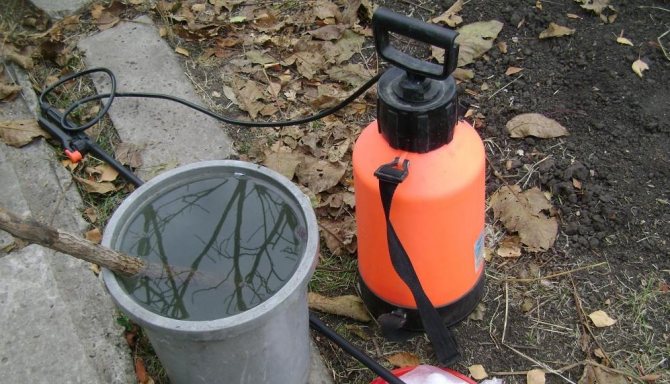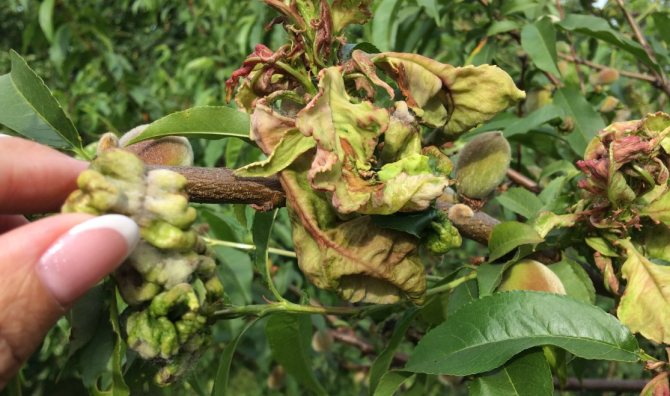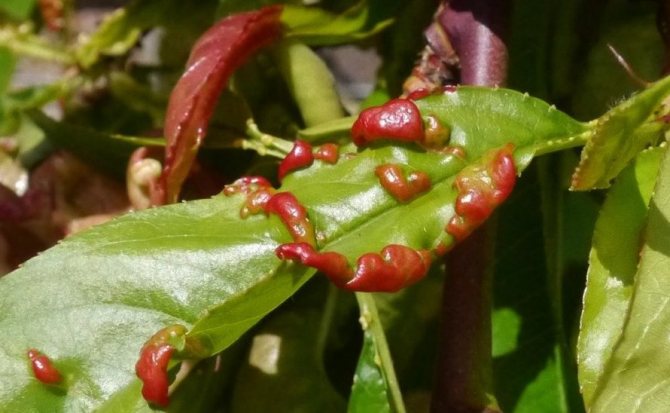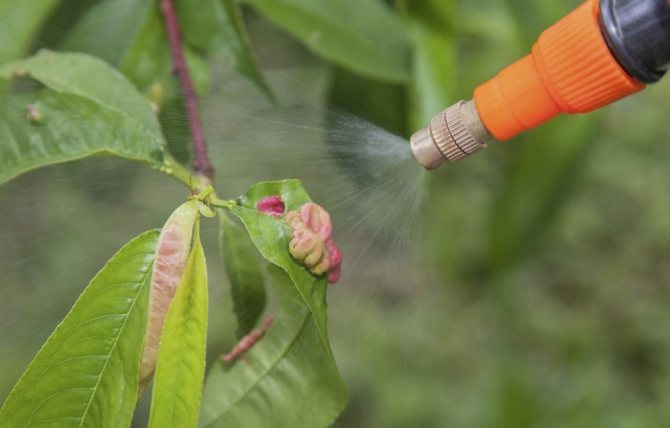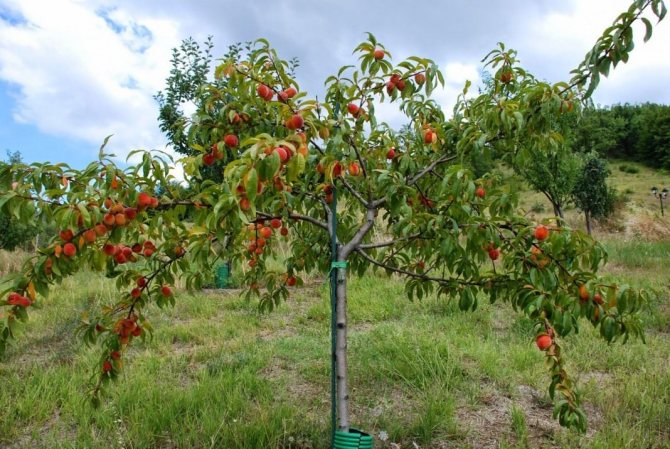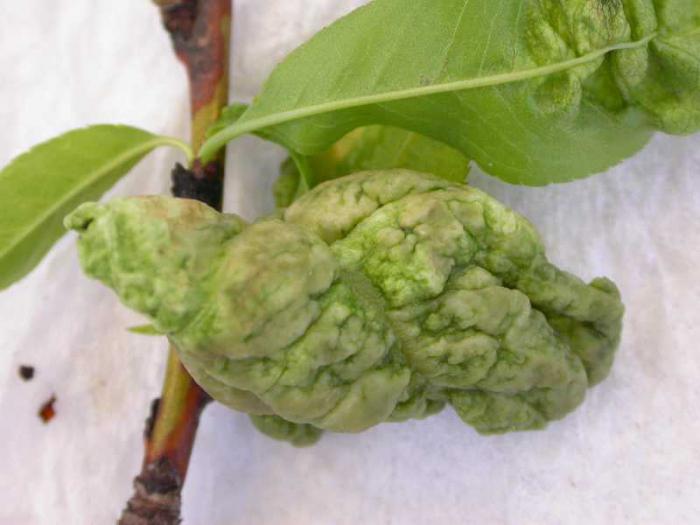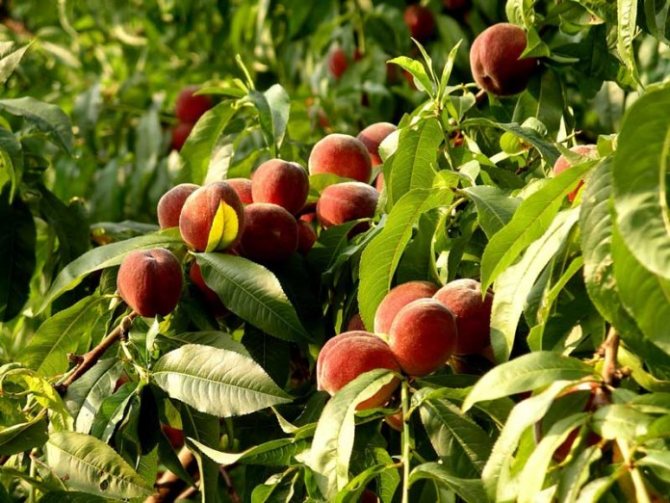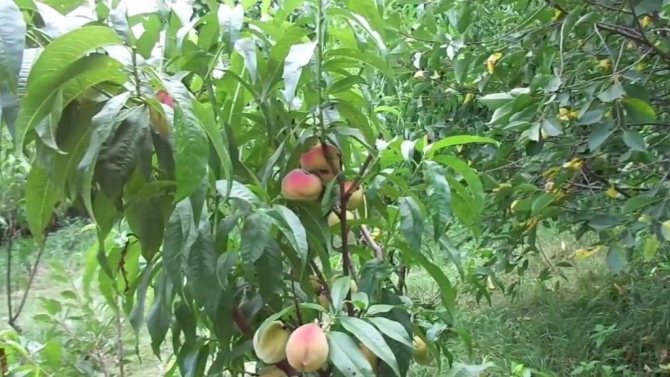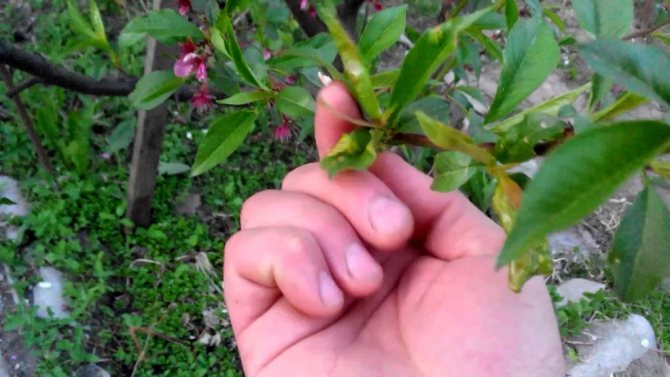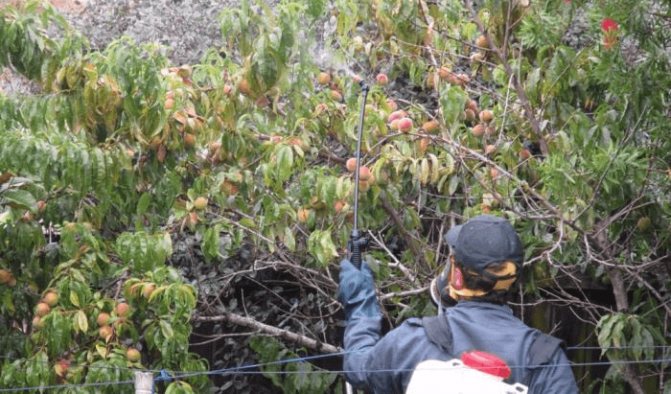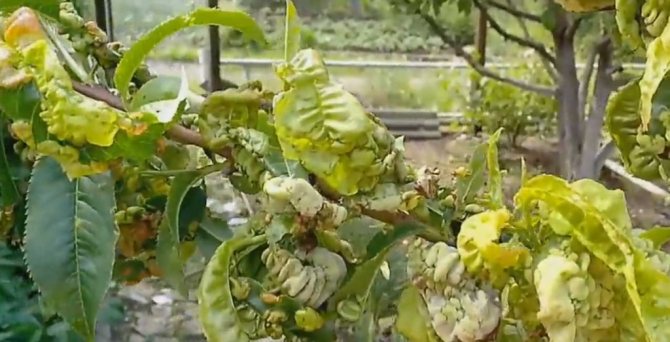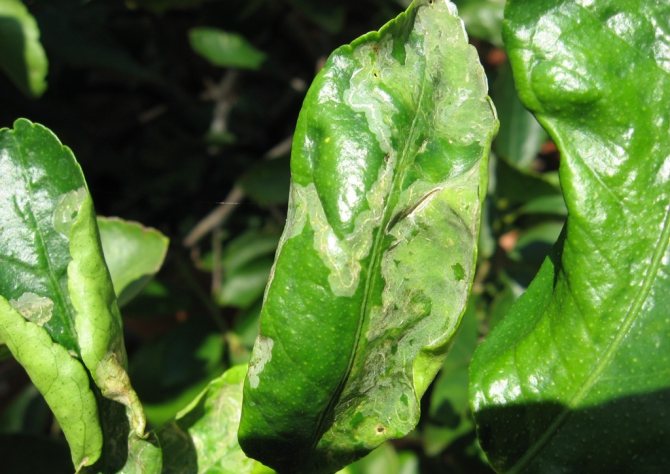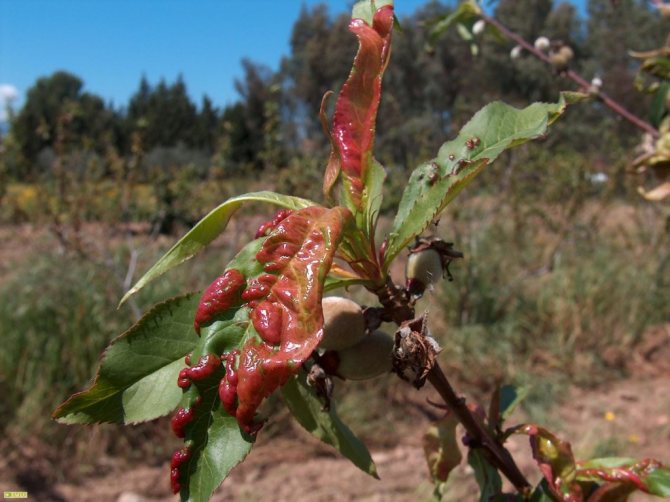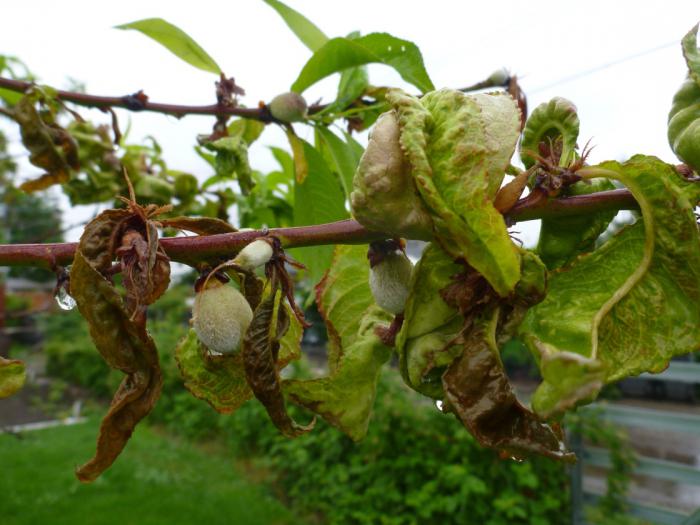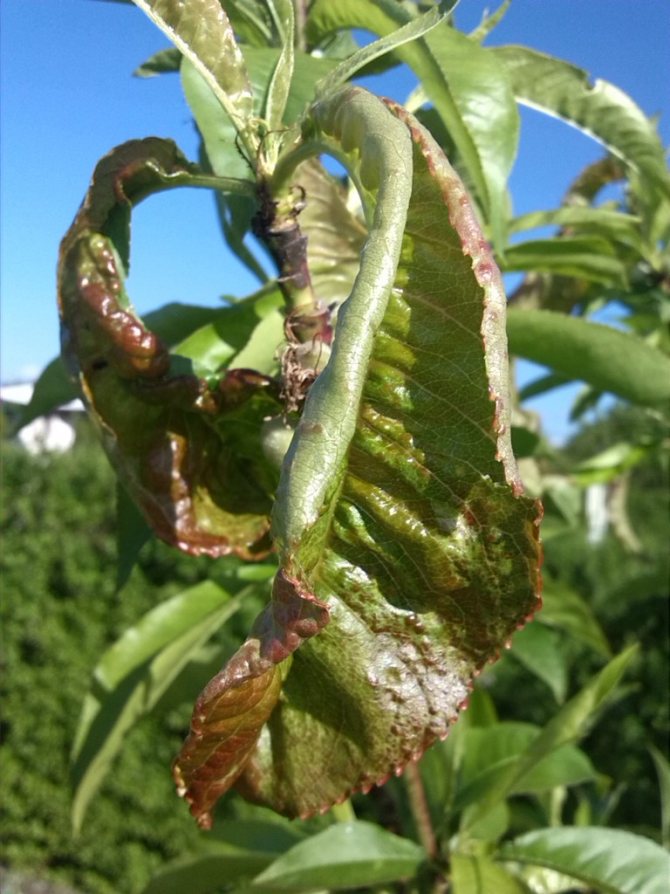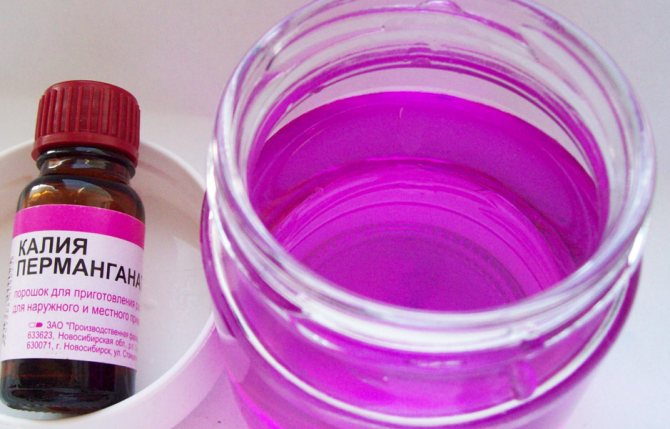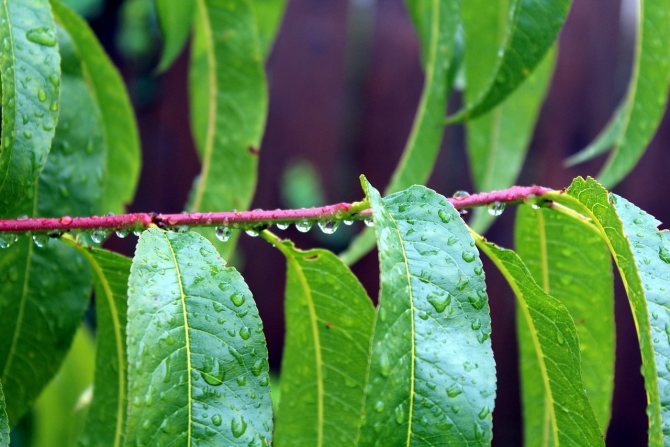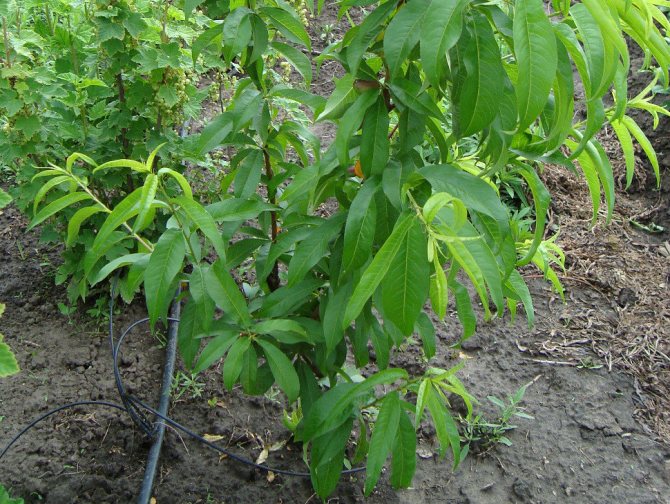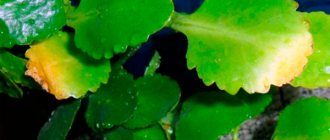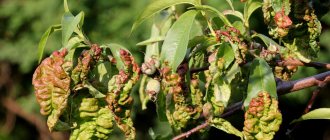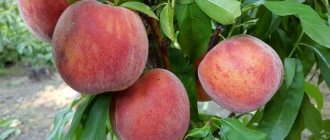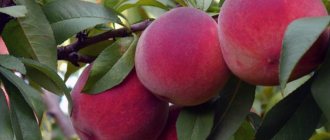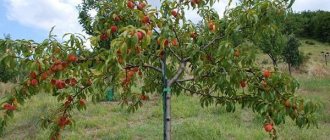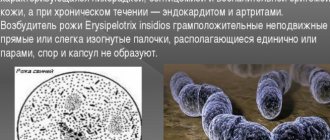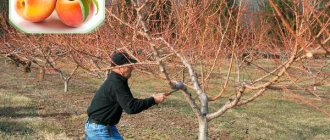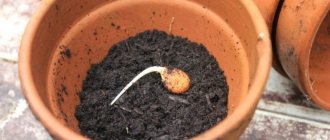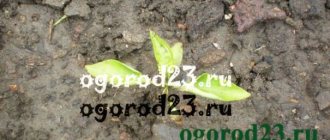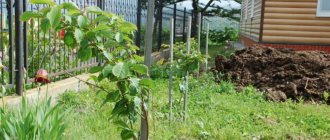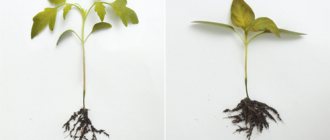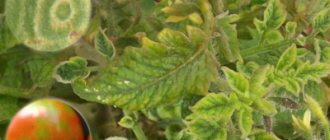Peach is a rather delicate and vulnerable crop. There are many unfavorable factors that prevent you from growing a healthy tree and a good harvest. One of them is the peach leaf curl disease, which can be called the scourge of culture. It is common in all regions where the peach grows, so gardeners need to know the signs of the disease and how to deal with it.
- 2 How to treat peach from curly leaves
2.1 Table: Scheme of peach treatments for leaf curl
How is the disease manifested and what is the danger?
Peach leaf curl is a fungal disease that occurs in the spring. It is with the arrival of heat that the shoots grow vigorously and the fungus immediately overpowers the peaches. The disease manifests itself on young foliage and shoots. Leaves that are 5 days old will become infected faster than 2-week-old counterparts.
The manifestation of malaise is expressed in the form of blistering tumors on the leaves. Initially, they are light greenish in color, then they acquire an amber-reddish color, and then they become brown with a waxy gray coating. This is where fungal spores mature.
Bubbles on the foliage gradually become fragile, the leaves themselves thicken, dry out, turn black and fall off. First the lower ones, then in the middle of the process. Ultimately, few leaves remain at the tip of the shoot.
Shoots at the age of 1-2 years and the branches themselves are affected. They acquire a yellow tint, thickening, curvature and soon dry out. Trees without shoots stop bearing fruit. Affected buds die off in the first year of infection without fruit. If, nevertheless, they are formed, then they turn out to be deformed.
Plant damage symptoms
The disease manifests itself at the very beginning of the growing season. Young, newly opened leaves are characterized by a yellowish or red-pink color and a corrugated surface.
The size of the affected leaves is much larger than healthy green ones. Over time, the lower part of the infected leaves acquires a waxy white coating - sporulation of fungi. The diseased leaves soon turn brown, crumble, exposing the base of the process. Infected shoots dry up, survivors, as a rule, freeze at the beginning of the freeze.
The absence or untimely spraying of a peach seedling from curl will ultimately lead to the exposure of the entire tree. It is weakening and is unlikely to survive the next winter frosts.
Signs of tree infection
Curliness in the described culture initially manifests itself in the form of greenish swellings on the leaf blade, which subsequently turn red and darken. The tissues of the leaves thicken, and because of their underdevelopment and their uneven growth, they twist. Infected leaves, covered with a so-called waxy coating, turn black over time, dry out and die off.
Tree branches are also subject to infection, manifested in the form of:
- gum formation;
- deformation of shoots;
- visible yellowness;
- drying.
See also
How to plant a seed and grow a peach from it at homeRead
After the withering away of the foliage, the ovaries also die.
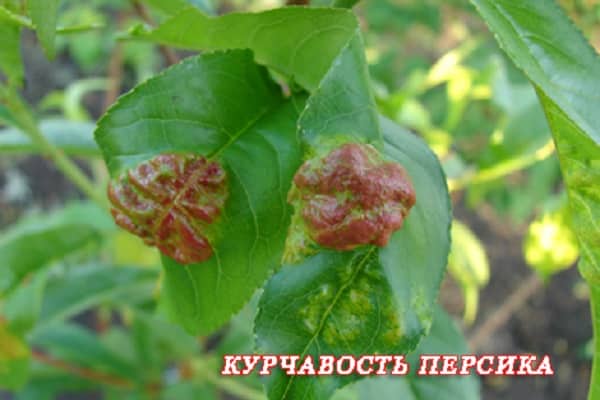
Removal of diseased leaves
Removing infected leaves of peach trees is considered a preventive and sanitizing measure. It should be carried out in the spring or autumn.
Spring pruning involves pruning infected, curly and dried shoots to swollen buds. They must be collected and burned outside the garden to prevent the spread of fungal spores.
In the fall, branches with obvious symptoms of the disease are cut off, the fallen affected foliage is collected, taken to a remote area and burned.
How to deal with curly peach leaves?
Fighting unpleasant curly foliage in peach crops includes:
- removal and incineration of contaminated wood pieces;
- loosening the soil between plants;
- autumn and spring spraying with sulfur-lime solution.
Peaches are very sensitive to curly foliage. Therefore, to detect a disease during the growing season, seedlings must be carefully examined. Prolonged wet weather increases the risk of spreading the disease.
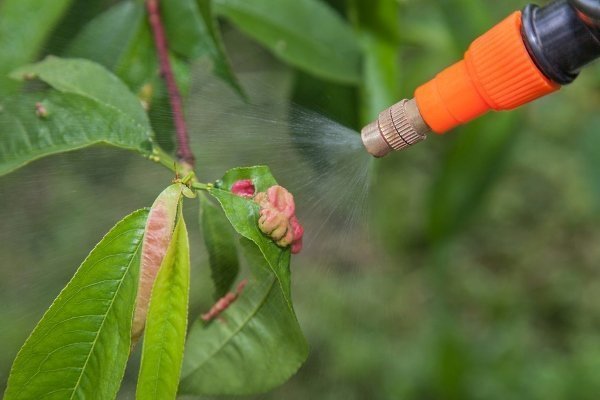

Agrotechnical control measures
Pruning of affected branches should be carried out using the following tools: garden knife, saw;
- secateurs;
- lopper.
Tools must be sharp and disinfected.
Peach trees are bad for any intrusion into their livelihoods. Therefore, so that the plant does not hurt, pruning must be carried out quickly, correctly, if necessary, with further processing of the sections.
Chemical control measures
For effective cure of peach curl, fungicides are used, the composition of which includes copper ("Skor", "Raek", "Folpan"), Bordeaux 3% liquid, copper sulfate.
You need to apply "Speed" in this way:
- 1 capsule (2 ml) of the product is dissolved in 10 liters of water for 1 hundred square meters of garden;
- the therapeutic effect is achieved after 5 days, prevention is 10 days.
The use of "Abiga-Peak" is as follows:
- 40-50 g of the drug is dissolved in 10 l of water;
- sprayed 4 times at intervals of 14 days.
The products are non-toxic, practically harmless to amateur gardeners and the atmosphere.
Causes and factors of manifestation of the disease
At the initial stage of the disease, the lower surface of young leaves is covered with a whitish bloom formed by the marsupial sporulation of this fungus.
The causative agent of the described disease in the form of budding ascospores spends its wintering between the scales of the buds or in the cracks of the bark of trees. And the weather favorable for the fungus with rains, dampness and coolness provokes its development and further infection of the tree. That is why it is the arrival of spring that can contribute to a new outbreak of the disease.
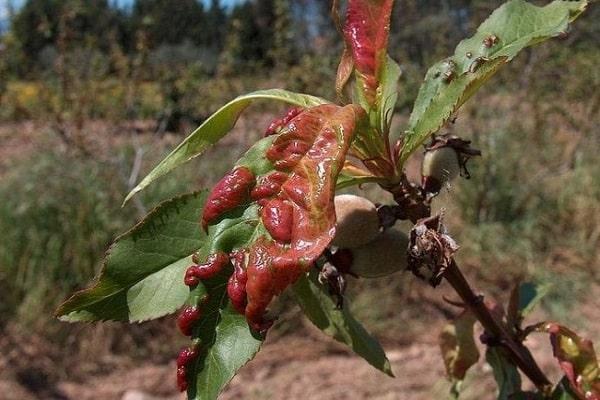

How to spray against curl?
The most optimal products for the war against disease, gardeners secrete copper-containing agents that effectively destroy fungal diseases and harmful insects that spread the disease.
Biological agents ("Guapsin", "Planriz", "Trichodermin") are widely used. They do not adversely affect green plantings and do not accumulate inside the seedlings.
These drugs are used to combat the disease before and after peach blossom. At the time of fruiting, the funds do not affect the taste of the fruit. The effect of bacterial spraying appears after 2-3 days.
Experienced gardeners offer combination spraying, which is widespread and has a positive effect:
- Early in the spring before bud break - 3% emulsion of copper (iron) vitriol or Bordeaux mixture.
- Time of the pink ovary phase - if the temperature is less than 20 ° C - "Chorus", if more than 20 ° C - "Strobe".
- Immediately after flowering - "Skor", "Tilt".
- 14 days after the last treatment (with obvious places of infection) - "Skor", "Baylon".
- After the leaves fall - a 3% solution of vitriol, Bordeaux liquid.
Clay processing
Treat diseases of peach trees using folk methods. One of the most effective methods is considered to be clay mortar with limestone, which has fungicidal characteristics and increases the self-protection of peach plantations from fungus.
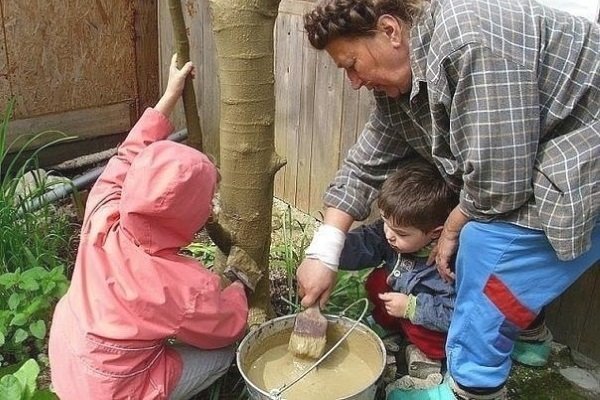

To prepare a miracle cure, take:
- 10 liters of water;
- 350 g soft clay;
- 90 g limestone (pre-extinguish).
Then:
- combine water with added clay;
- stir well;
- pour out the white milk in a gentle stream.
The mixture must be uniform, without any precipitation. Make the emulsion solution strictly at the time of spraying.
Processing with Bordeaux mixture
Bordeaux mixture for foliage healing has different effectiveness, depending on how it is made. The most effective in attempts to get rid of fungal infections is considered to be a 3% Bordeaux mixture, made by pouring a diluted solution of copper sulfate into white milk.
To process a peach seedling, prepare Bordeaux 3% liquid as follows:
- per 10 liters of water, take 300 g of ferrous sulfate, 300 g of slaked lime;
- dissolve vitriol in 5 liters of warm water;
- separately in a container (non-metallic) dissolve milk of lime in 5 liters of water;
- pour the mixture of vitriol in a small stream into the milk of lime, remembering to stir constantly.
Please note that the quality of the Bordeaux mixture will be poor if you mix strong solutions of copper sulfate and lime milk and if you pour a strong solution of copper sulfate into a weak solution of milk of lime.
Dealing with high humidity in the greenhouse
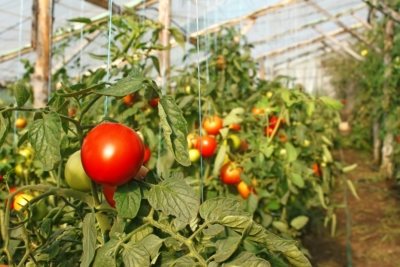

The virus spreads well under certain favorable conditions. One of these conditions is high humidity. Therefore, be sure to regulate watering, but do not overdo it, especially if the tomatoes grow in a greenhouse. In the heat, the plants are watered every 2-3 days, but you still need to check the soil before moistening. If it is still damp, then postpone this matter until the soil is completely dry.
How to speed up the recovery of a damaged peach?
Rehabilitation of trees after illness is possible with the following measures:
- Ensure the supply of the right amount of nutrients: systematically feed the soil with minerals and organic matter.
- In autumn, take care of protecting weak seedlings from freezing in winter.
- If the trees are affected by freezing weather, do proper pruning to rehabilitate the foliage. In severely damaged ones, remove all ovaries.
- Carry out treatments with various immunostimulating drugs, growth stimulants, phytoactivators of resistance to the disease: ("Stimmunol", "Novosil", "Zircon").
You need to cut peach shoots depending on the level of damage to the wood:
- if the share of the buds is frozen and the wood is not damaged, cut out the branches without flowers;
- in case of damage to all ovaries or frostbite of shoots, cut out longitudinal branches up to 4-5 years old wood, transfer them to lateral branching;
- in case of damage to skeletal shoots, pruning should be carried out in the summer (in June), when new branches will grow from the awakened buds and it will be possible to assess the picture of wood infection.
Correctly performed actions to restore a peach after an illness will increase the chances of healing the tree and getting good yields.
The gardener in his video talks about how he saved a peach from "curly leaves":
Destruction of parasites
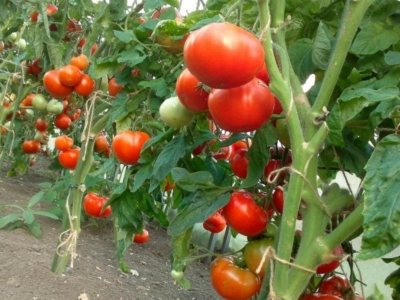

When fighting parasites, it is important not to allow the creation of conditions conducive to their reproduction, namely:
- High humidity.
- An overabundance of dressings.
- Lots of weeds.
- Lack of soil disinfection before sowing.
- Overconsolidation of the soil, lack of loosening.
Against the whitefly, which is most often the cause of tomato curliness, a remedy such as "Phosbecid" is used.
Disease prevention
Timely measures will protect peach trees from a parasitic disease that is easier to prevent than cure.
Protective actions are carried out before the opening of the ovaries early in the spring. In different territories of Russia, the time of prevention is adjusted to the atmospheric environment: in the south, actions are carried out in early March, in northern areas - in April. Finishing takes place in the fall.
Start the prevention of foliar damage in the fall. As soon as the air temperature drops to 5 degrees, carry out the following procedures:
- cut off infected trees and spray with vitriol or a gray-lime solution;
- free the area around the trunk from residues, burn foliage and branches, loosen the soil;
- in the early days of March, treat the tree by spraying with a 1% mixture of copper sulfate;
- repeat the procedure after 7 days;
- it is possible to use a 3% solution of Bordeaux liquid.
In order to reduce the risk of ailment, choose dry, not darkened garden areas for planting peach seedlings.
Terms of medical procedures
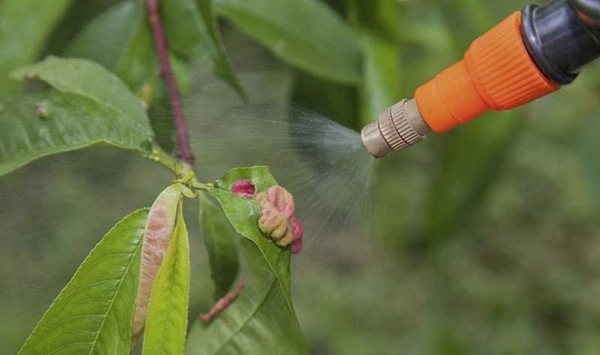

Struggle for plant health, a rich harvest begins in spring or autumn. When a disease is detected, branches and shoots are cut off in the spring, on which traces of infection have been noticed. Circumcision should be done before the buds appear. Branches on which the lesion is clearly visible can also be cut off in the fall, the main thing is not to forget to collect the fallen leaves.
Attention!
Everything that is affected by the disease is best taken away from the garden, burned to avoid further spread of the disease.
Optimal schedule of procedures:
- end of February, beginning of March;
- in mid-March, until the buds appear;
- before the beginning of the appearance of buds, the first decade of April;
- immediately after flowering in early May.
Such a four-time treatment will significantly increase the chances of success and reduce the risk of infection.
Disease Resistant Peach Varieties
According to gardeners, species of peach trees, in which fruits with yellow fleshy flesh, are less likely to fall ill with curly foliage. The greatest disease resistance to fungal diseases was recorded in the following varieties:
- Golden Moscow;
- Kiev early;
- Golden Jubilee;
- Early Simferopol;
- Early Kuban.
Regardless of which type of peach was chosen, prevention is the best protection of the plant from curliness. Peach stands are pampered, heat-loving areas. The tree will quickly die if you do not follow agricultural techniques and preventive options for protection against damage by fungi and pests.
0
Helpful information
The tree becomes ill due to the defeat of the marsupial fungus, and the infection spreads only in the spring. Dangerous spores enter through cracks in the bark, shoots, and through them you can see oozing gum. And the diseased foliage becomes a source of the disease, the spores of the fungus fall on the bark, they winter successfully in it, and in the spring the breeding cycle resumes.
The fungus can settle on any fruit tree, but most often it settles on peaches and nectarines, and if an effective fight is not started in time, then by mid-May the trees can completely shed all their foliage and ultimately die. But what an early Kiev peach looks like, and what diseases can be, is indicated here.

